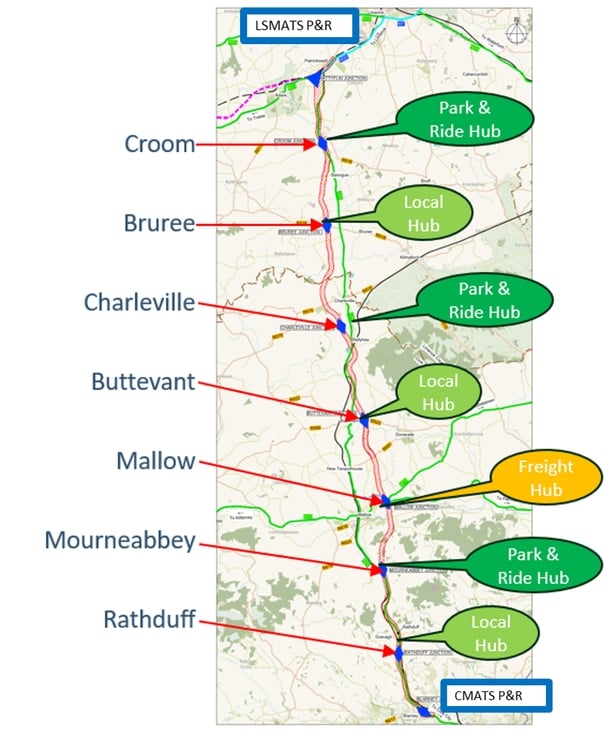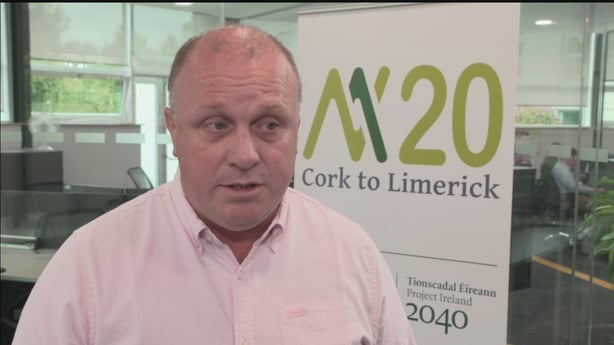The proposed new 80km road linking the country's second and third largest cities - Cork and Limerick - is to be a tolled motorway.
The National Road Design team behind the N/M20 project made the recommendation. The the cost to build the route is put at €2 billion.
The announcement is a further step in advancing the project to improve connectivity between the two cities, the preferred route for which was announced last November.
Government approval for the motorway - which will include major interchanges at Charleville and Mallow, as well as six transport hubs, a freight hub and 100km of safely segregated routes for walkers and cylists - is to be sought next year.
We need your consent to load this rte-player contentWe use rte-player to manage extra content that can set cookies on your device and collect data about your activity. Please review their details and accept them to load the content.Manage Preferences
The N/M20 project team, led by Limerick City and County Council, with the support of Transport Infrastructure Ireland, said its design would be five times safer than the current single carriageway.
Project coordinator Jari Howard said that several options were looked at, but a motorway is the safest one statistically.
"Safety is a huge priority for the project. It obviously gives the advantage of the higher speed of 120km/h - that improves the journey time savings on the project," Mr Howard said.
He added: "Overall it was deemed that that was the best cross section to take forward".

In its latest update on the project, the team also confirmed that the 80km route will be tolled.
Mr Howard said that as well as encouraging people to use other forms of transport such as buses, trains, bikes or sharing cars, it will also go towards funding maintenance of the motorway.
"It brings a lot of positives in encouraging sustainable transport use, like trying to get people onto buses, and active travel. We have to develop the project in line with the Climate Action Plan, so it supports these measures," Mr Howard said.
He said the toll will be based on distance travelled.
"Instead of having one toll location on there (the route), that toll is spread over the whole thing, so you only pay for the section of road you use.
"It is more equitable in that regard. A modest toll for each of the junctions and that will help minimise toll avoidance, going through villages and places like Charleville," Mr Howard said.
"It is a huge new asset to maintain, and we are going to maintain that to a high standard, not just the motorway, but the active travel (route) and the hubs, so the revenue generated by the tolling will help cover the maintenance and renewal of that asset into the future".
The new route will begin at the existing dual carriageway at Blarney in Co Cork and join the existing M20 motorway at Patrickswell in Co Limerick.

The need for improvements to the N20 was first identified in a 1998 National Roads study, and a previous scheme was put on hold soon after the financial crash.
A commitment to upgrade the route is in the Programme for Government and it is a key element of the Government's Ireland 2040 plan.
Development of the south and midwest as an economic counterbalance to the east of the country was one of the drivers for the project, for which safety is also a major factor.
Analysis of road collision figures between 2016 and 2018 showed crashes on the N20 were four times more likely to be fatal than the national average.
The six transport hubs with park and share/ride facilities will be at Rathduff, Mourneabbey, Buttevant and Charleville in Cork, and at Buree and Croom in Limerick.
The freight hub will be in Mallow.
"At each of the major junctions we are going to have a transport hub which is going to allow people to change from one mode of transport to another, whether that's the car to a bus or train, or active travel, or carpooling. We are providing safe spaces for that," Mr Howard said.
"The freight hub in Mallow is particularly important for professional drivers, for heavy goods drivers, to have that safe space to have a rest and break, with facilities and EV charging.
"We are trying to future proof this; we are trying to decarbonise the transport sector."
Consultation with affected property owners is to continue, with the detailed design now available publicly from today online.
The final design and the business case will be submitted to Government with the intention to apply for planning permission in 2025.







